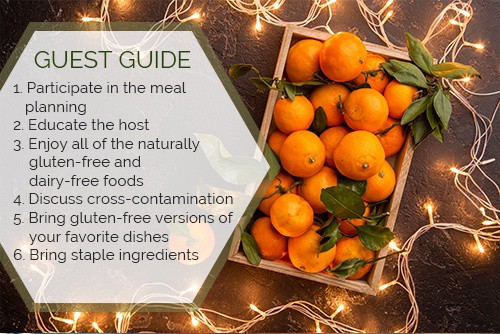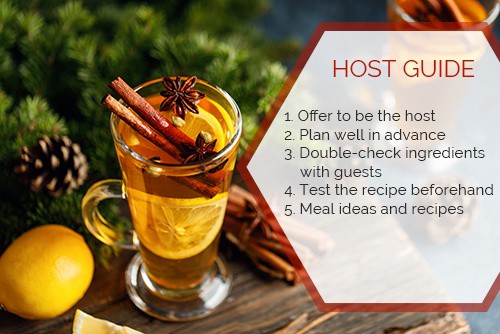Guest Guide
 1. Participate in the meal planning.
1. Participate in the meal planning.
Call the host in advance. Let them know you’re gluten-free and the other special dietary needs your family has. Find out if they are up for the challenge. Discuss with them what they plan to serve. Ask how you can help. Providing some gluten-free recipes can make it easier for the host.
2. Educate the host.
It can be stressful for a host when they are not knowledgeable about special dietary needs—and they certainly don’t want to feed you something that will make you or your children sick. Educate them on hidden sources of gluten and simple alternatives. This will make a more pleasant experience and provide the host a better feeling of certainty. For example, some people put flour in a demi-glaze for a turkey—by talking these things out you can eliminate any surprises.
3. Enjoy all of the naturally gluten-free and dairy-free foods.
Help the host see all of the naturally gluten free and dairy free foods available. This will help them see how easy it can be to be GFCF. Vegetables, fruit, meat, eggs, and nuts are free of gluten and dairy. Encourage the host to put dressings on the side so that your family can enjoy these foods in their natural state free of allergens.
4. Discuss cross-contamination.
If you are at someone else’s home, educate the host on cross-contamination.
If the meal is not fully GFCF, inform the host of the need to use different serving utensils for the special items and the guests not to mix up the serving pieces. If the dinner is served as a buffet and not fully GFCF, see if you can help arrange the GFCF dishes together is a separate spot.
5. Bring gluten-free versions of your favorite dishes.
If you have kids that LOVE a particular dish, offer to cook and bring the dish for everyone to share. For example, if you know your kids are going to want pumpkin pie and you’ve already perfected it, make it yourself.
6. Bring staple ingredients.
Bringing gluten-free bread, a gluten-free flour blend, or your favorite dairy-free butter alternative, can make it easier for the host. It also prevents you from feeling you are “imposing” on a host that is unfamiliar with your special diet. Bringing a few staples can help you whip up a special diet-compliant option on the spot.

 1. Participate in the meal planning.
Call the host in advance. Let them know you’re gluten-free and the other special dietary needs your family has. Find out if they are up for the challenge. Discuss with them what they plan to serve. Ask how you can help. Providing some gluten-free recipes can make it easier for the host.
2. Educate the host.
It can be stressful for a host when they are not knowledgeable about special dietary needs—and they certainly don’t want to feed you something that will make you or your children sick. Educate them on hidden sources of gluten and simple alternatives. This will make a more pleasant experience and provide the host a better feeling of certainty. For example, some people put flour in a demi-glaze for a turkey—by talking these things out you can eliminate any surprises.
3. Enjoy all of the naturally gluten-free and dairy-free foods.
Help the host see all of the naturally gluten free and dairy free foods available. This will help them see how easy it can be to be GFCF. Vegetables, fruit, meat, eggs, and nuts are free of gluten and dairy. Encourage the host to put dressings on the side so that your family can enjoy these foods in their natural state free of allergens.
4. Discuss cross-contamination.
If you are at someone else’s home, educate the host on cross-contamination. If the meal is not fully GFCF, inform the host of the need to use different serving utensils for the special items and the guests not to mix up the serving pieces. If the dinner is served as a buffet and not fully GFCF, see if you can help arrange the GFCF dishes together is a separate spot.
5. Bring gluten-free versions of your favorite dishes.
If you have kids that LOVE a particular dish, offer to cook and bring the dish for everyone to share. For example, if you know your kids are going to want pumpkin pie and you’ve already perfected it, make it yourself.
6. Bring staple ingredients.
Bringing gluten-free bread, a gluten-free flour blend, or your favorite dairy-free butter alternative, can make it easier for the host. It also prevents you from feeling you are “imposing” on a host that is unfamiliar with your special diet. Bringing a few staples can help you whip up a special diet-compliant option on the spot.
1. Participate in the meal planning.
Call the host in advance. Let them know you’re gluten-free and the other special dietary needs your family has. Find out if they are up for the challenge. Discuss with them what they plan to serve. Ask how you can help. Providing some gluten-free recipes can make it easier for the host.
2. Educate the host.
It can be stressful for a host when they are not knowledgeable about special dietary needs—and they certainly don’t want to feed you something that will make you or your children sick. Educate them on hidden sources of gluten and simple alternatives. This will make a more pleasant experience and provide the host a better feeling of certainty. For example, some people put flour in a demi-glaze for a turkey—by talking these things out you can eliminate any surprises.
3. Enjoy all of the naturally gluten-free and dairy-free foods.
Help the host see all of the naturally gluten free and dairy free foods available. This will help them see how easy it can be to be GFCF. Vegetables, fruit, meat, eggs, and nuts are free of gluten and dairy. Encourage the host to put dressings on the side so that your family can enjoy these foods in their natural state free of allergens.
4. Discuss cross-contamination.
If you are at someone else’s home, educate the host on cross-contamination. If the meal is not fully GFCF, inform the host of the need to use different serving utensils for the special items and the guests not to mix up the serving pieces. If the dinner is served as a buffet and not fully GFCF, see if you can help arrange the GFCF dishes together is a separate spot.
5. Bring gluten-free versions of your favorite dishes.
If you have kids that LOVE a particular dish, offer to cook and bring the dish for everyone to share. For example, if you know your kids are going to want pumpkin pie and you’ve already perfected it, make it yourself.
6. Bring staple ingredients.
Bringing gluten-free bread, a gluten-free flour blend, or your favorite dairy-free butter alternative, can make it easier for the host. It also prevents you from feeling you are “imposing” on a host that is unfamiliar with your special diet. Bringing a few staples can help you whip up a special diet-compliant option on the spot.
 1. Offer to be the host.
By being the host, you can take the worry and fear out of any potential food infractions that could ruin the day. Hosting the holiday event, dinner or party will ensure the meal meets the dietary needs of your family. When you are the host, you can relax and enjoy all of the food, knowing that everything is gluten-free.
2. Plan well in advance.
It will be less stressful for you as the host (or for the host), if you are not running around at the last minute trying to find a special ingredient or a recipe. It’s often easy to make a substitute if you know in advance. For example, gravy can me made gluten-free very easily by using a thickener like cornstarch or gluten-free flour.
3. Double-check ingredients with guests.
Don’t leave it up to the person preparing the dish to confirm it’s gluten-free and casein-free. If others people are bringing dishes, ask them to send you the recipe ahead of time so you can ensure it free of gluten, dairy and other problematic ingredients. Also, ask guests to bring the packaging for prepared foods. Live at the party is not the best time to check with guests, and don’t expect them to go based on memory. At one holiday, a friend who is aware of the gluten-free diet, was going through the ingredients in the recipe in her mind at the party—and forgot an ingredient had gluten—unfortunately she didn’t realize this until days later – after it was too late!
4. Test the recipe beforehand.
If you haven’t made the recipe before, try a test run before the event. Most hosts learn from experience that the day of a big event is not the best time to test a recipe.
5. Meal ideas and recipes.
For holiday recipes you can access right away, here are some free recipes from my blog: Gluten-free Stuffing, Gluten-Free Gravy, and Confetti Brussels Sprouts.
1. Offer to be the host.
By being the host, you can take the worry and fear out of any potential food infractions that could ruin the day. Hosting the holiday event, dinner or party will ensure the meal meets the dietary needs of your family. When you are the host, you can relax and enjoy all of the food, knowing that everything is gluten-free.
2. Plan well in advance.
It will be less stressful for you as the host (or for the host), if you are not running around at the last minute trying to find a special ingredient or a recipe. It’s often easy to make a substitute if you know in advance. For example, gravy can me made gluten-free very easily by using a thickener like cornstarch or gluten-free flour.
3. Double-check ingredients with guests.
Don’t leave it up to the person preparing the dish to confirm it’s gluten-free and casein-free. If others people are bringing dishes, ask them to send you the recipe ahead of time so you can ensure it free of gluten, dairy and other problematic ingredients. Also, ask guests to bring the packaging for prepared foods. Live at the party is not the best time to check with guests, and don’t expect them to go based on memory. At one holiday, a friend who is aware of the gluten-free diet, was going through the ingredients in the recipe in her mind at the party—and forgot an ingredient had gluten—unfortunately she didn’t realize this until days later – after it was too late!
4. Test the recipe beforehand.
If you haven’t made the recipe before, try a test run before the event. Most hosts learn from experience that the day of a big event is not the best time to test a recipe.
5. Meal ideas and recipes.
For holiday recipes you can access right away, here are some free recipes from my blog: Gluten-free Stuffing, Gluten-Free Gravy, and Confetti Brussels Sprouts.




Thanks for all the great tips Julie, I love reading your newsletter.
Is there dairy free yoghurt and butter ?
My daughter lives in a group home. She bakes apple pie once/wk.
What is the best flour and butter to use to ensure the pie does not turn out to have the consistency of a rock?
Brita, Personally I love Miyoko’s dairy-free butter. There are lots of dairy-free yogurts such as coconut milk based options. I love to hear that your daughter bakes in her home. There are many good flour blends. I like making one with rice flour, tapioca flour, and potato starch, along with xanthan gum or other binder for the “glutenous, gummy” quality.